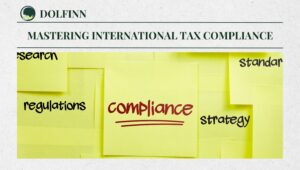
International Tax Compliance: What Every Multinational Needs to Know
In 2025, businesses face a financial landscape marked by fluctuating interest rates, evolving market dynamics, and supply chain uncertainties. Amid these challenges, effective cash flow management remains a cornerstone of financial stability. Whether you’re running a small business or a global enterprise, optimizing cash flow is critical for maintaining liquidity, reducing reliance on debt, and seizing growth opportunities. Let’s dive into practical strategies to master cash flow management.
Understanding Cash Flow Management
Cash flow management is the process of tracking, analyzing, and optimizing the movement of money into and out of your business. Unlike profitability, which reflects overall financial performance, cash flow focuses on liquidity—the availability of cash to meet immediate obligations. A well-managed cash flow ensures smooth operations, strategic investments, and resilience against economic shocks.
For instance, imagine a small bakery. While its monthly profits might look good on paper, delays in customer payments can result in cash shortages, making it difficult to pay suppliers or staff. Effective cash flow management can prevent such issues.
Why Cash Flow Management is Crucial
- Operational Continuity: Timely cash inflows enable uninterrupted business operations. For example, a manufacturing company can ensure the steady purchase of raw materials only if cash flow is consistent.
- Debt Reduction: Minimizing reliance on short-term borrowing saves costs. For instance, avoiding high-interest short-term loans can save thousands annually.
- Growth Facilitation: Access to cash allows businesses to invest in innovation and expansion, such as launching a new product line or entering a new market.
Practical Strategies for Cash Flow Management in 2025
1. Optimize Accounts Receivable
Efficient receivable processes ensure timely cash inflows.
- Automate Invoicing: Tools like QuickBooks or FreshBooks reduce manual errors and improve payment tracking. For example, a freelance graphic designer can set up automated reminders for recurring clients.
- Offer Early Payment Discounts: Encourage quicker payments with incentives (e.g., 2% off for payments within 10 days). For instance, a printing company might see a 15% reduction in average payment time by implementing this.
- Streamline Follow-Ups: Develop protocols for tracking and addressing overdue payments. For example, using CRM software like HubSpot can automate follow-ups with clients.
2. Reassess Pricing Strategies
Market fluctuations require periodic pricing reviews.
- Benchmark Against Competitors: Ensure prices reflect market trends and value provided. For example, a SaaS company might adjust subscription plans after analyzing competitors’ offerings.
- Introduce Tiered Pricing: Cater to varying customer segments to maximize revenue. A gym could offer basic, premium, and VIP memberships.
- Communicate Clearly: Proactively explain price changes to maintain customer trust. For instance, a local café might share a newsletter detailing the impact of rising coffee bean prices.
3. Tighten Inventory Management
Inventory ties up valuable cash. Streamline management by:
- Leveraging Sales Data: Forecast demand to avoid overstocking. For example, a clothing retailer can use historical data to stock popular seasonal items.
- Implementing Just-In-Time Systems: Minimize inventory while meeting production needs. Toyota’s JIT strategy is a classic example.
- Clearing Excess Stock: Offer promotions to sell slow-moving items. For instance, a tech store could offer discounts on older gadget models before launching new stock.
4. Conduct Expense Audits
Identify and eliminate non-essential expenses.
- Cut Unused Subscriptions: Review recurring expenses regularly. For example, a startup might cancel redundant software subscriptions, saving $500 per month.
- Negotiate with Vendors: Secure better terms or discounts from suppliers. A restaurant might negotiate bulk discounts on ingredients.
- Adopt Sustainability Practices: Reduce utility costs with energy-efficient solutions. For instance, replacing traditional lighting with LED bulbs can cut electricity bills by 30%.
5. Establish a Business Line of Credit
Lines of credit provide financial flexibility during cash flow gaps.
- Research Lenders: Compare terms to secure favorable rates. For example, a small business might choose a credit union over a commercial bank for better terms.
- Use Judiciously: Limit usage to short-term needs, avoiding overreliance. For instance, a retailer might use the credit line to cover holiday inventory surges.
- Maintain a Safety Net: Reserve for emergencies rather than operational expenses, like unexpected equipment repairs.
6. Perform Year-End Cash Flow Audits
Analyze financial trends to improve future cash flow.
- Identify Patterns: Spot trends in inflows and outflows. For instance, an e-commerce business might notice seasonal spikes during the holidays.
- Address Weaknesses: Pinpoint areas for immediate improvement, such as delayed payments from key clients.
- Plan Strategically: Set clear financial goals for the upcoming year, such as reducing payment cycles by 10%.
7. Build a Cash Reserve
Strong reserves act as a safety net for unforeseen expenses.
- Set Realistic Goals: Save three to six months of operating expenses. For example, a marketing agency might aim to build a $50,000 reserve.
- Use Surplus Wisely: Prioritize reserves without stalling growth. For instance, reinvesting 20% of annual profits while saving the rest.
Advanced Cash Flow Optimization Techniques
Cash Flow Forecasting
Forecasting helps anticipate cash needs and avoid shortfalls.
- Analyze Historical Data: Identify recurring cash flow patterns. For example, a landscaping business might predict slower cash flow during winter.
- Account for Market Factors: Include economic conditions and regulatory changes in forecasts, like rising minimum wages.
- Scenario Planning: Prepare for best, worst, and average-case scenarios. For instance, a travel agency might model cash flows under different booking demand levels.
Managing Accounts Payable
Optimize payables to retain cash longer.
- Negotiate Payment Terms: Request extended payment windows. For example, asking for 60-day terms instead of 30 days.
- Evaluate Discounts: Consider if early payment discounts outweigh holding cash. For instance, saving 2% on a $50,000 invoice may justify early payment.
- Streamline Processes: Use ERP systems to automate and manage payments efficiently.
Inventory Turnover Analysis
Monitor inventory turnover to improve liquidity.
- Track Key Metrics: Use the inventory turnover ratio to evaluate performance. For example, high turnover might indicate strong sales, while low turnover signals overstocking.
- Address Slow-Moving Stock: Run promotions to reduce stagnant inventory. For instance, offering “Buy One, Get One” deals on older items.
- Adopt Inventory Tools: Ensure real-time tracking for better decision-making. Tools like TradeGecko or Zoho Inventory can help.
Financial Ratios to Monitor Cash Flow
Using financial ratios provides a snapshot of liquidity and financial health.
- Current Ratio: Measures the ability to cover short-term liabilities (ideal >1). For example, a ratio of 1.5 indicates healthy liquidity.
- Quick Ratio: Excludes inventory for a more stringent liquidity measure. A ratio of 1.2 suggests solid short-term cash availability.
- Cash Conversion Cycle (CCC): Tracks the time taken to convert investments into cash inflows. For instance, reducing CCC from 90 days to 75 days improves liquidity.
Preparing for Financial Success in 2025
Effective cash flow management is essential for navigating the uncertainties of 2025. By optimizing receivables, controlling inventory, and maintaining cash reserves, businesses can reduce risks and position themselves for sustainable growth. Start implementing these strategies today to build a financially resilient tomorrow.
FAQs
1. Why is cash flow management vital in 2025?
Economic challenges require businesses to maintain liquidity for uninterrupted operations and growth.
2. How does automation improve cash flow?
Automation reduces errors, saves time, and ensures timely payments through streamlined processes.
3. What is an ideal cash reserve?
Experts recommend saving three to six months’ worth of operating expenses for emergencies.
4. What’s the difference between current and quick ratios?
The current ratio considers all current assets, while the quick ratio excludes inventory for a stricter liquidity assessment.
5. How can I forecast cash flow accurately?
Combine historical data, market analysis, and scenario planning to create actionable forecasts.
Summary
Navigate the financial complexities of 2025 with our expert guide on cash flow management. Discover actionable strategies to optimize liquidity, reduce debt, and fuel business growth. Whether you’re a startup or a global enterprise, these insights are your roadmap to financial resilience.
Latest Posts
- Top Cash Flow Forecasting Tools You Can’t Ignore for Global Businesses

- Mastering Profit vs. Cash Flow: 5 Key Strategies for Financial Success

- 5 Key Advantages and Disadvantages of Outsourced Accounting: Is Outsourced Accounting Worth the Risk?

- Mastering Cash Flow Management in 2025: 7 Proven Strategies for Financial Success

- Mastering International Tax Compliance: 7 Crucial Strategies for Multinational Success

- 5 Common Bookkeeping Mistakes Small Businesses Make and How to Avoid Them

